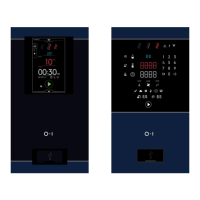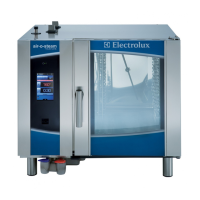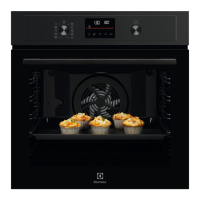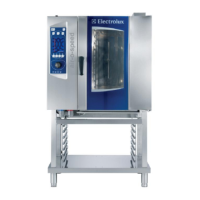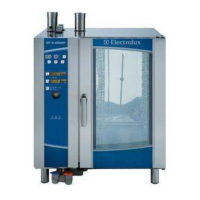Do you have a question about the Electrolux SkyLine PremiumS and is the answer not in the manual?
Explains terms and typographical conventions used in the documentation for safe appliance use.
Summarizes Personal Protection Equipment (PPE) required for different stages of appliance operation.
Details safety devices and general precautions to ensure safe operation and prevent hazards.
Describes fixed and movable guards, and access panels as protection devices on the appliance.
Lists and explains prohibition and danger safety signs used on or near the appliance.
Defines improper use and lists activities that can involve risks for operators and the appliance.
Identifies residual risks not completely eliminated by design or protection devices.
Provides important instructions for maintaining appliance performance and safeness through cleaning.
Recommends regular service by authorized engineers for safety and performance.
Emphasizes using only original accessories and spare parts to maintain warranty and safety.
Highlights risks of mechanical, thermal, and electrical nature and necessary precautions during use.
Discusses inspection and maintenance intervals, advising scheduled maintenance contracts.
Details warranty coverage, conditions, and common exclusions for the product.
Provides context about the manual's content and the examples used within it.
Specifies the appliance's design purpose and defines any use deemed improper.
Confirms appliances are designed and tested for high performance and efficiency.
States the manual is for consultation only and requires permission for third-party distribution.
Instructs to keep the manual carefully for the appliance's entire life.
Identifies the intended audience for the manual: employer, users, and service personnel.
Lists and defines key terms used throughout the manual for clarity.
Outlines manufacturer's disclaimer for damage caused by non-compliance or improper actions.
Specifies that personnel must be adequately trained and skilled for appliance operation.
Outlines necessary knowledge and understanding for safe and correct appliance operation.
Highlights the importance of manual instructions for correct and optimum oven use.
Provides a specific recommendation for GFCI outlet usage on 120v gas versions.
Presents diagrams and labels for the 6-10 GN and 20 GN model appliance components.
Provides step-by-step instructions for opening and closing the oven door for different models.
Illustrates and labels the components of the appliance's control panel.
Explains how to switch the oven on and off using the designated button.
Describes the main menu and its various cooking modes and functions.
Details icons indicating the oven's connection status to the cloud.
Explains interaction icons, commands, and signalling information on the touch screen.
Describes the upper and lower drawers which contain various menu options and functions.
Details the manual operation mode, allowing customization of cooking cycles.
Presents the initial page of the manual mode, showing key cooking parameters.
Details the available cooking cycles: Convection, Combi, and Steam.
Guides on selecting and setting parameters for a cooking cycle like Combi.
Explains how to set a delayed start for a cooking cycle to begin at a later time.
Covers options like Auto Start and Two Touch mode for managing cycle initiation.
Describes the end-of-cycle indications, including acoustic signals and summary messages.
Explains temperature adjustment options like ECO DELTA for advanced cooking methods.
Details how to adjust humidity levels for STEAM and COMBI cycles.
Covers options for continuous cooking and displayed time format conversion.
Explains the use of the core probe for accurate control of food's internal temperature.
Allows setting different times for recipes or pans, enabling 'à la carte' cooking.
Enables programming cooking cycles with multiple sequential phases (up to 16).
Allows performing cooking automatically by setting few functions.
Guides on setting up an automatic cooking cycle by selecting food type and presets.
Explains how to update or restore automatic cooking cycles using a USB pendrive.
Contains special cooking approaches designed to obtain specific results.
Provides a preset program for even cooking of food with a soft texture.
Adjusts cavity temperature based on food core probe for constant difference cooking.
A cycle to reheat chilled food while controlling humidity.
Simulates static cooking with gentle air distribution, without fan adjustment.
Uses controlled humidity and temperature to function as a proving cabinet.
A steam cycle for cooking or regenerating food vacuum sealed in a plastic bag.
Associates pasteurization factor achievement with the end of the cooking cycle.
Enables microbiological SAFE condition control of food during cooking.
For foods with high contamination levels, ensuring SAFE consumption.
Quickly dehydrates fruits, vegetables, meat, and fish by drying the oven chamber.
A special preset cycle suitable for fresh pasta pasteurization.
Allows recalling, creating, and storing program recipes from cloud or locally.
Provides links to most used features, allowing display customization.
Offers QR codes to display the user manual on a device (smartphone, tablet, laptop).
Allows planning oven activities, cooking, or cleaning programs, and setting reminders.
Enables uploading/downloading programs, presets, or data via a USB pendrive.
Optimizes consecutive cookings to reduce energy and water consumption during transitions.
Allows connecting the oven with a blast chiller via Wi-Fi or Ethernet.
Provides reminders for hood maintenance based on operating time.
Allows automatic cleaning of the oven cavity by choosing the most suitable program.
Measures elapsed cooking time since last automatic cleaning and enforces cleaning if limit is reached.
Addresses excessive scale in the boiler, requiring specific cleaning cycles.
States that care operations are to be carried out by the owner and/or user.
Explains that oven soiling depends on cooking type and location.
Provides information on cleaning parts and frequency based on oven usage.
Suggests daily cleaning of the cooking chamber, possibly more often with specific cooking types.
Recommends daily descaling for boilers, noting the Green Spirit feature excludes it.
Describes the filter's function to prevent pump damage and obstructions.
Explains the polyurethane sponge filter's role in preventing internal component malfunctions.
Highlights the gasket's importance for cooking results and preventing leakage; recommends daily cleaning.
Emphasizes keeping oven door glass clean for visibility and temperature shielding.
Recommends daily cleaning of the door perimeter, gasket, and internal glass.
Stresses the importance of checking and cleaning the external discharge pipe for efficiency.
Provides hygiene instructions for cleaning the drip collector and its components.
Recommends daily cleaning of the food probe to ensure accurate temperature detection.
Advises using non-aggressive detergents for external glass, metal, and plastic parts.
Lists precautions for appliance shutdown during periods of non-use.
Explains how the display signals the need for boiler descaling.
Notes that parts damaged by normal use are not covered by the manufacturer's warranty.
States that repair and maintenance must be carried out by authorized specialized personnel.
Provides a table detailing maintenance checks, frequency, and responsibilities.
Guides on how to address common faults that can occur during normal appliance use.
Lists anomalies, their descriptions, possible causes, and recommended actions.
Discusses the product's ergonomic features assessed and certified for user interaction.
States that the product has been assessed and certified for ergonomic requirements.
Provides suggestions for minimizing physical problems during interaction with the product.
Suggests specific accessories and their use for easier loading and installation.
Explains terms and typographical conventions used in the documentation for safe appliance use.
Summarizes Personal Protection Equipment (PPE) required for different stages of appliance operation.
Details safety devices and general precautions to ensure safe operation and prevent hazards.
Describes fixed and movable guards, and access panels as protection devices on the appliance.
Lists and explains prohibition and danger safety signs used on or near the appliance.
Defines improper use and lists activities that can involve risks for operators and the appliance.
Identifies residual risks not completely eliminated by design or protection devices.
Provides important instructions for maintaining appliance performance and safeness through cleaning.
Recommends regular service by authorized engineers for safety and performance.
Emphasizes using only original accessories and spare parts to maintain warranty and safety.
Highlights risks of mechanical, thermal, and electrical nature and necessary precautions during use.
Discusses inspection and maintenance intervals, advising scheduled maintenance contracts.
Details warranty coverage, conditions, and common exclusions for the product.
Provides context about the manual's content and the examples used within it.
Specifies the appliance's design purpose and defines any use deemed improper.
Confirms appliances are designed and tested for high performance and efficiency.
States the manual is for consultation only and requires permission for third-party distribution.
Instructs to keep the manual carefully for the appliance's entire life.
Identifies the intended audience for the manual: employer, users, and service personnel.
Lists and defines key terms used throughout the manual for clarity.
Outlines manufacturer's disclaimer for damage caused by non-compliance or improper actions.
Specifies that personnel must be adequately trained and skilled for appliance operation.
Outlines necessary knowledge and understanding for safe and correct appliance operation.
Highlights the importance of manual instructions for correct and optimum oven use.
Provides a specific recommendation for GFCI outlet usage on 120v gas versions.
Presents diagrams and labels for the 6-10 GN and 20 GN model appliance components.
Provides step-by-step instructions for opening and closing the oven door for different models.
Illustrates and labels the components of the appliance's control panel.
Explains how to switch the oven on and off using the designated button.
Describes the main menu and its various cooking modes and functions.
Details icons indicating the oven's connection status to the cloud.
Explains interaction icons, commands, and signalling information on the touch screen.
Describes the upper and lower drawers which contain various menu options and functions.
Details the manual operation mode, allowing customization of cooking cycles.
Presents the initial page of the manual mode, showing key cooking parameters.
Details the available cooking cycles: Convection, Combi, and Steam.
Guides on selecting and setting parameters for a cooking cycle like Combi.
Explains how to set a delayed start for a cooking cycle to begin at a later time.
Covers options like Auto Start and Two Touch mode for managing cycle initiation.
Describes the end-of-cycle indications, including acoustic signals and summary messages.
Explains temperature adjustment options like ECO DELTA for advanced cooking methods.
Details how to adjust humidity levels for STEAM and COMBI cycles.
Covers options for continuous cooking and displayed time format conversion.
Explains the use of the core probe for accurate control of food's internal temperature.
Allows setting different times for recipes or pans, enabling 'à la carte' cooking.
Enables programming cooking cycles with multiple sequential phases (up to 16).
Allows performing cooking automatically by setting few functions.
Guides on setting up an automatic cooking cycle by selecting food type and presets.
Explains how to update or restore automatic cooking cycles using a USB pendrive.
Contains special cooking approaches designed to obtain specific results.
Provides a preset program for even cooking of food with a soft texture.
Adjusts cavity temperature based on food core probe for constant difference cooking.
A cycle to reheat chilled food while controlling humidity.
Simulates static cooking with gentle air distribution, without fan adjustment.
Uses controlled humidity and temperature to function as a proving cabinet.
A steam cycle for cooking or regenerating food vacuum sealed in a plastic bag.
Associates pasteurization factor achievement with the end of the cooking cycle.
Enables microbiological SAFE condition control of food during cooking.
For foods with high contamination levels, ensuring SAFE consumption.
Quickly dehydrates fruits, vegetables, meat, and fish by drying the oven chamber.
A special preset cycle suitable for fresh pasta pasteurization.
Allows recalling, creating, and storing program recipes from cloud or locally.
Provides links to most used features, allowing display customization.
Offers QR codes to display the user manual on a device (smartphone, tablet, laptop).
Allows planning oven activities, cooking, or cleaning programs, and setting reminders.
Enables uploading/downloading programs, presets, or data via a USB pendrive.
Optimizes consecutive cookings to reduce energy and water consumption during transitions.
Allows connecting the oven with a blast chiller via Wi-Fi or Ethernet.
Provides reminders for hood maintenance based on operating time.
Allows automatic cleaning of the oven cavity by choosing the most suitable program.
Measures elapsed cooking time since last automatic cleaning and enforces cleaning if limit is reached.
Addresses excessive scale in the boiler, requiring specific cleaning cycles.
States that care operations are to be carried out by the owner and/or user.
Explains that oven soiling depends on cooking type and location.
Provides information on cleaning parts and frequency based on oven usage.
Suggests daily cleaning of the cooking chamber, possibly more often with specific cooking types.
Recommends daily descaling for boilers, noting the Green Spirit feature excludes it.
Describes the filter's function to prevent pump damage and obstructions.
Explains the polyurethane sponge filter's role in preventing internal component malfunctions.
Highlights the gasket's importance for cooking results and preventing leakage; recommends daily cleaning.
Emphasizes keeping oven door glass clean for visibility and temperature shielding.
Recommends daily cleaning of the door perimeter, gasket, and internal glass.
Stresses the importance of checking and cleaning the external discharge pipe for efficiency.
Provides hygiene instructions for cleaning the drip collector and its components.
Recommends daily cleaning of the food probe to ensure accurate temperature detection.
Advises using non-aggressive detergents for external glass, metal, and plastic parts.
Lists precautions for appliance shutdown during periods of non-use.
Explains how the display signals the need for boiler descaling.
Notes that parts damaged by normal use are not covered by the manufacturer's warranty.
States that repair and maintenance must be carried out by authorized specialized personnel.
Provides a table detailing maintenance checks, frequency, and responsibilities.
Guides on how to address common faults that can occur during normal appliance use.
Lists anomalies, their descriptions, possible causes, and recommended actions.
Discusses the product's ergonomic features assessed and certified for user interaction.
States that the product has been assessed and certified for ergonomic requirements.
Provides suggestions for minimizing physical problems during interaction with the product.
Suggests specific accessories and their use for easier loading and installation.
| Brand | Electrolux |
|---|---|
| Model | SkyLine PremiumS |
| Category | Oven |
| Language | English |


